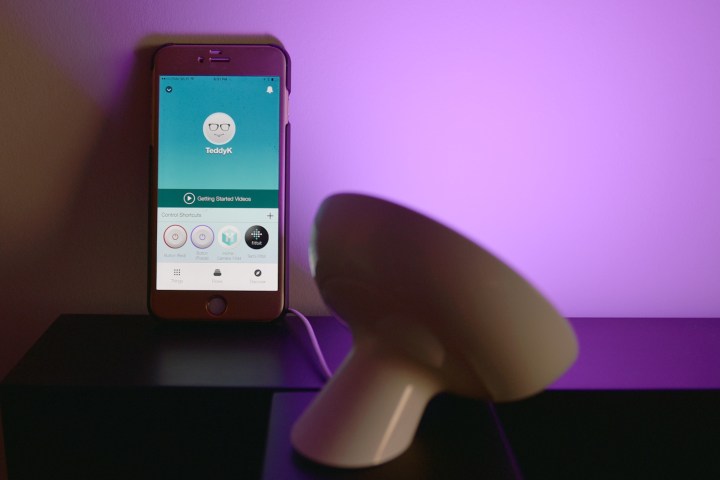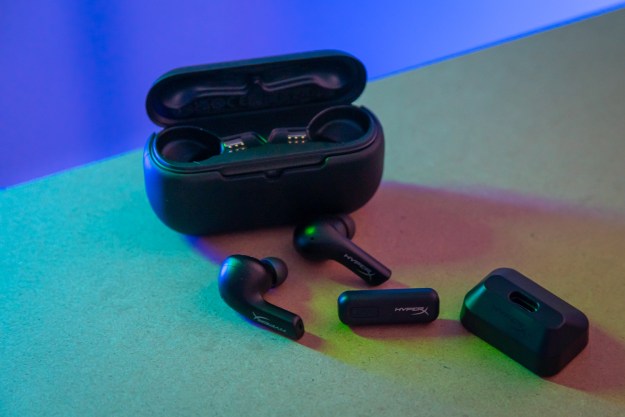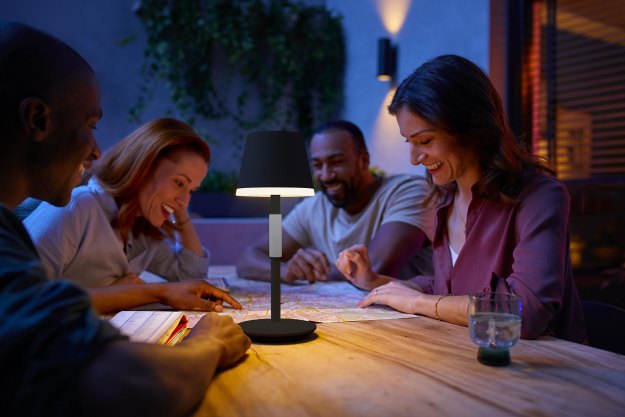
Enter Stringify, a newer app that aims to out automate IFTTT by “stringing” things together, only with greater flexibility that does away with simple one-to-one automations and throws more into the mix. Digital Trends played with the service for three months to see if we would feel strung along — or convinced to make the switch.
Starting out slowly
Without question, Stringify is fighting an uphill battle, and since everyone loves an underdog, its potential is intriguing. The hill it’s climbing appears steeper than it may actually be, however, due to compatibility — or a lack thereof. For example, there is currently only an iOS app (Android is coming), and there’s no web portal like IFTTT’s. The number of supported devices and services currently pales in comparison to IFTTT as well, though we can forgive that if expansion is consistent moving forward.

The only hardware hub Stringify really supports is Samsung’s SmartThings, which can help broaden support for devices that wouldn’t otherwise be on the list (like Sonos, for instance). But it isn’t a requirement to use Stringify.
Setting up a free account involves no more than a username and password with an email verification; SmartThings requires its own username and password, with peripheral device support set up through its own dedicated app before being integrated with Stringify. And new devices or services that run through SmartThings must be added through the SmartThings app, not Stringify.
An instructional video does help explain the basics — what Stringify is and how it works — but we were left to our own devices to figure out any nuances. Those became more apparent over time, yet starting out wasn’t so bad once we figured out how to best integrate the SmartThings Hub and go from there.
Recipes vs. Flows
IFTTT calls them “Recipes,” while Stringify goes with “Flows.” The premise is the same: Choose one thing to trigger another actionable thing. The main difference is that a Flow does not have to be a single one-to-one sequence. Instead, it can be a chain that triggers multiple apps and services, making one intrinsically more flexible.
Stringify is fighting an uphill battle, but since everyone loves an underdog, its potential is intriguing.
The apps and services are called “Things” and the idea is to link them together in a Flow with a trigger and action. Included in the list of Things are three control buttons (red, purple, and green) that can be used to trigger a Flow immediately. The list of Things is nowhere near as extensive as IFTTT’s overall support and compatibility, but there were some good ones we made use of, including Philips Hue, Fitbit, Dropbox, Facebook, and more. Other currently supported Things include Amazon Alexa, Automatic, Ecobee, Ring, Nest, Slack, Misfit, Honeywell, Evernote, Withings, Yelp, and Twitter, among others.
What’s neat about Stringify’s methodology is the way in which triggers and actions are strung together. For example, we created a Flow wherein Hue lights in the bedroom would light up as we entered a certain proximity to home, while disarming a Homeboy camera at the same time. IFTTT would require separate recipes to pull both off. Another Flow turned on Hue lights in the living room turn and played music through the Sonos system on a certain day of the week (provided it has a playlist to use). Not quite as intricate, but again, not as easy to pull off with IFTTT.

The caveat is that it takes some trial and error to get the Flows just right. The drag-and-drop method seems simple enough, yet it’s a matter of tapping the right buttons, too. After adding the Things we wanted, there were gear icons at the top corner of each one, meaning the app or service needed to be told what to do. Tapping the icon opened a settings page that required defining the Thing as a trigger or action, and then the parameters in which it’s to do something. The Homeboy camera could be used either way, for example. We could have it trigger Hue lights to turn on the moment it detects movement, or have it activate the moment we leave a certain geofenced area around the home.
What’s neat about Stringify’s methodology on Flows is the way in which triggers and actions are strung together.
We could also make it a little more complicated. Arm the Homeboy camera only between 10 a.m. and 6 p.m. from Mondays to Fridays, and if motion is detected, turn on Hue lights, send us an email, and turn off the lights again after 60 seconds. To do all that with IFTTT would require multiple recipes that couldn’t be forged together. Stringify offers cool flexibility that way, though understanding how to pull all these things together on your first or second attempt isn’t so straightforward – we’d like the process to be made more understandable. It also wasn’t immediately obvious that Flows could be entirely limited, meaning one could be used only on a specific day before it disabled itself.
Granted, it does take time to acclimate to an automation app, except the inclusion of multiple elements in a Flow raises the chance of a mistake along the chain. That’s not because Stringify is really buggy (it was quite stable) but because the setup has to be unassailable. Stringify won’t confirm a Flow unless the chain links a trigger to an action. The details governing the connection between them has no real scrutiny, and that’s where the mistakes are easy to make.
The only reason we could add Sonos to a Flow was because of the SmartThings Hub.
More shortcuts and compatibility, please
When dealing with multiple elements that shouldn’t be entirely automated, a quick button press might be good enough to do the job. Remember we mentioned three control buttons (red, purple, and green) in the list of Things? We wish they would add more. Utterly efficient and convenient, the buttons are great for quick actions to set off a Flow on-demand. It’s even better when the button can be set up for a Flow that is timely and specific. The problem is that once we committed to using one of the three for a Flow we used often, we couldn’t program it to do something else.

It’s sure to be an issue as compatibility grows, and the need for quick action may compel Stringify developers to bring more in. IFTTT has separate DO apps that essentially do the same thing because there is no such shortcut on the app itself.
Even so, the compatibility gap between them is noticeable. IFTTT has an exhaustive list of apps, devices, and services that can be plugged in for recipes, whereas Stringify is still building that out. For example, Nest, Netatmo, and Homeboy are the three home-networked cameras it currently supports. IFTTT more than doubles that. Smart thermostats are pretty even, but general smart home devices, apps, and websites are a different story.
Stringify doesn’t support Belkin’s WeMo products, nor can it work with D-Link’s networking products or other hubs, like Wink or Harmony. Apps are also constrained. There’s no way to tap into a phone’s calling or text functions to create a Flow where you can be alerted via text about something like a camera detecting motion or a photo that was uploaded to a shared folder on Dropbox. Shopping apps are virtually non-existent, unless you count eBay and Craigslist as options. Flickr and Instagram are the only photography options. Fitbit, Jawbone UP, Misfit, and Withings are the only wearable ones.
Basically, Stringify has focused on securing the more widely adopted ones first in order to foster adoption. How quickly the services expands to include the ones it’s missing, plus others that could be very useful, remains to be seen.
Conclusion
It’s hard to gauge how much the average smartphone user knows about, or uses, IFTTT and automator apps in general. But in any case, Stringify needs to push further before all of this truly goes mainstream. The idea of multi-stringed Flows has plenty of merit, and with slightly better execution, particularly on setup, Stringify could emerge as an effective competitor.
As is, its utility is largely based on whether you have the compatible stuff that works with it. A SmartThings Hub isn’t a must to get the most out of Stringify, but it doesn’t hurt to get the $100 device if you’re willing to dive right in and give it a shot.
The good news is that even with only two compatible apps, services, or devices, it’s easy to give Stringify a tryout and see how well it works. We think that’s worth your time, especially since developers have been consistent in updating the app and confirmed that compatibility will continue to grow.
Score: 3/5
Highs
- Flows increase functionality
- Supports many well-known apps and devices
- Slick and efficient when set up properly
- Shortcut buttons
- Free to download and use
Lows
- More compatible products needed
- Setting up Flows could be easier
- Needs an Android app soon
- IFTTT has greater support
Editors' Recommendations
- Dyson’s new AR mobile app shows where you forgot to clean
- How to use the Google Home app on a computer
- Roborock shows off highly automated robot vacuums at CES 2024
- Eufy’s new X9 Pro Robovac offers automated mopping and vacuuming for less than $1,000
- The new Google Home app officially launches on May 11



